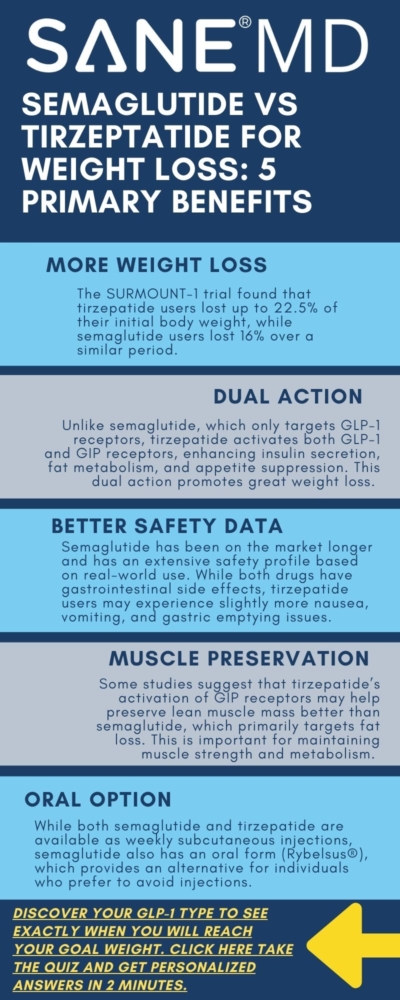Semaglutide vs Tirzepatide for Weight Loss: Which is Better?
Dr. Matthew Olesiak, MD, is the Chief Medical Director at SANESolution, a renowned wellness technology company dedicated to providing evidence-based solutions for optimal living. Dr. Olesiak earned his medical degree from the prestigious Jagiellonian University Medical College in Kraków, Poland, where he developed a strong foundation in medicine.
With the growing prevalence of obesity and related health conditions such as diabetes and high blood pressure, many individuals are turning to weight loss medications to help achieve weight loss and improve overall health.
Two of the most promising options available today are semaglutide and tirzepatide, both of which are GLP-1 medications that function as receptor agonists and have shown significant effects in clinical trials. Understanding the key differences between these two medications can help patients and healthcare providers determine the proper medication for their needs.
This article provides an objective comparison of semaglutide vs tirzepatide for weight loss, mechanism of action, effectiveness, side effects, and potential risks.
Key Takeaways
- Tirzepatide and semaglutide are both FDA-approved medications used for chronic weight management and diabetes management.
- Studies suggest patients receiving tirzepatide, a dual agonist, may experience significantly greater weight loss compared to those taking semaglutide.
- Side effects for both drugs include gastrointestinal adverse events, such as nausea and vomiting, though they have a different side effect profile.
Semaglutide vs Tirzepatide: A Comparison Table
| Feature | Semaglutide | Tirzepatide |
|---|---|---|
| Medication Type | GLP-1 Receptor Agonist | GLP-1 & GIP Dual Agonist |
| Mechanism of Action | Mimics GLP-1 hormone to regulate blood sugar and appetite | Mimics both GLP-1 and GIP hormones for enhanced insulin secretion and appetite regulation |
| FDA Approval | Approved for weight loss and diabetes management | Approved for diabetes, pending broader weight loss indication |
| Average Weight Loss | 16% of initial body weight | 22.5% of initial body weight |
| Key Benefits | Effective weight loss, appetite suppression, improves blood sugar control | Greater weight loss, improved blood sugar control, possible muscle mass preservation |
| Side Effects | Nausea, vomiting, diarrhea, constipation, abdominal discomfort | More gastrointestinal side effects, including nausea, vomiting, and delayed gastric emptying |
| Administration | Weekly subcutaneous injection or oral form | Weekly subcutaneous injection |
| Insurance Coverage | Varies by provider; more widely covered than Tirzepatide | More expensive; coverage varies by provider and plan |
Obesity and Related Health Issues
Obesity is a major public health concern, affecting millions of individuals worldwide. It is linked to numerous weight-related medical problems, significantly increasing the risk of severe chronic diseases. Individuals with obesity and excess weight are more likely to experience conditions such as type 2 diabetes, high blood pressure, heart disease, stroke, and metabolic syndrome.
One of the most concerning complications is obstructive sleep apnea (OSA), a condition in which the airway becomes partially or completely blocked during sleep, leading to disrupted breathing patterns. OSA is common in individuals with obesity, as excess fat around the neck and airway can contribute to airway obstruction.
Additionally, obesity is a risk factor for chronic kidney disease (CKD) and other kidney problems due to its association with hypertension and diabetes, both of which can lead to long-term kidney damage. Studies have also shown that individuals with obesity have a higher likelihood of experiencing heart attacks and other cardiovascular complications.
Liver disease, including nonalcoholic fatty liver disease (NAFLD), is another growing concern linked to obesity. NAFLD can progress to nonalcoholic steatohepatitis (NASH), which may result in liver cirrhosis or failure if not managed effectively.
Given these risks, achieving and maintaining a healthy body weight through medical interventions, such as semaglutide and tirzepatide, can significantly reduce the likelihood of developing serious health conditions and improve overall quality of life.
How Do Semaglutide and Tirzepatide Work?
Both semaglutide and tirzepatide function as GLP-1 receptor agonists, meaning they mimic glucagon-like peptide-1 (GLP-1), a hormone that plays a crucial role in blood sugar regulation, insulin secretion, and gastric emptying. For a full breakdown of all GLP-1 receptor agonists, including their uses, dosages, and effectiveness, check out our GLP-1 Medications List guide.
By activating GLP-1 receptors, both medications enhance the body’s ability to manage blood sugar while also delaying gastric emptying, meaning food stays in the stomach longer, leading to decreased appetite and reduced caloric intake. This combination of effects helps compatible individuals lose weight by curbing hunger and promoting a feeling of fullness after eating.
However, tirzepatide has an additional mechanism that sets it apart: it acts as a dual agonist by also targeting glucose-dependent insulinotropic polypeptide (GIP) receptors. GIP is another hormone involved in insulin secretion, fat metabolism, and glucose control.
By targeting both GLP-1 and GIP receptors, tirzepatide provides a dual-action effect, enhancing insulin secretion more effectively than GLP-1 agonists alone. This dual mechanism has been shown to contribute to more significant weight loss compared to semaglutide in clinical trials.
Additionally, because GIP receptors are widely present in fat tissue, tirzepatide’s activation of these receptors may also affect how the body processes and stores fat, potentially improving on-treatment weight change outcomes.
Some researchers speculate that tirzepatide may improve energy balance by influencing the way the brain perceives hunger and satiety, although further studies are needed to fully understand this effect.
By combining GLP-1 receptor activation with GIP receptor stimulation, tirzepatide offers a unique and potentially more effective approach to chronic weight management. However, the added GIP receptor activation also means that patients receiving tirzepatide may experience a slightly different side effect profile, particularly in how the body responds to gastric emptying and insulin secretion.
Brand Names of Semaglutide and Tirzepatide
Several prescription medications contain semaglutide or tirzepatide as their active ingredient. The brand names include:
Semaglutide: Marketed under the brand names Ozempic®, Wegovy®, and Rybelsus®. If you’re considering semaglutide for weight loss, you may also want to compare Ozempic vs Trulicity for weight loss to see how it stacks up against other GLP-1 medications.
- Ozempic® is primarily prescribed for type 2 diabetes and blood sugar control.
- Wegovy® is specifically approved for chronic weight management in individuals with obesity or overweight.
- Rybelsus® is the oral form of semaglutide, approved for diabetes management.
Tirzepatide: Marketed under the brand names Mounjaro® and Zepbound®.
- Mounjaro® is approved for type 2 diabetes management and has shown promising results in weight loss, with ongoing studies evaluating its use for obesity treatment.
- Zepbound® is FDA-approved for chronic weight management, specifically for individuals with obesity or overweight with weight-related conditions.
Understanding the brand names of these medications can help patients and healthcare providers choose the most appropriate treatment based on health conditions, insurance coverage, and weight management goals.
Effectiveness in Substantial Weight Loss
Clinical Trial Results
Multiple clinical trials have compared the on-treatment weight outcomes of individuals with obesity receiving semaglutide versus obesity receiving tirzepatide. These studies provide clear insights into how these medications perform in real-world and clinical settings.
One of the most significant trials, SURMOUNT-1, evaluated the effects of tirzepatide on weight loss among adults with overweight or obesity. The study found that patients receiving tirzepatide at the highest dose (15 mg) achieved an average weight loss of 22.5% of their initial body weight over 72 weeks. This weight reduction was substantially greater than the 16% weight loss observed in obesity receiving semaglutide (2.4 mg) over a similar period in the STEP trials New England Journal of Medicine. (Opens in a new tab.)
This weight reduction was substantially greater than the 16% weight loss observed in obesity receiving semaglutide (2.4 mg) over a similar period in the STEP trials (New England Journal of Medicine).
A propensity score-matched population study comparing on-treatment weight change between the two medications found that patients receiving tirzepatide generally experienced significantly greater weight loss than those using semaglutide. This was observed across various baseline weight categories, suggesting that tirzepatide may be more effective across a broader patient population.
The superior weight reduction observed with tirzepatide is likely due to its dual mechanism of action, as it targets both GLP-1 and GIP receptors. This added pathway enhances insulin secretion, slows gastric emptying, and may further reduce appetite, leading to more significant weight loss than GLP-1 receptor agonists alone. For a comprehensive look at how GLP-1 drugs aid in weight loss and how different medications compare, visit our GLP-1 Drugs for Weight Loss guide.
Additionally, in an analysis of cohort studies, patients with available baseline weight data who switched from semaglutide to tirzepatide reported an additional percentage change in weight loss, suggesting that tirzepatide may provide benefits even for those who have previously struggled to lose weight with semaglutide alone.
“Both semaglutide and tirzepatide are highly effective for chronic weight management, but the dual action of tirzepatide often leads to substantial weight loss beyond what is observed with semaglutide,” says Dr. Matthew Olesiak, MD, Chief Medical Director at SANE MD.
While both medications demonstrate strong efficacy, choosing between them depends on factors such as medical history, insurance coverage, and tolerance to potential gastrointestinal adverse events.
Side Effects, Gastrointestinal Adverse Events, and Safety Considerations
Both semaglutide and tirzepatide are generally well-tolerated, but like all medications, they come with potential side effects. The most commonly reported side effects for GLP-1 drugs, as well as their GIP counterparts are gastrointestinal side effects, including nausea, vomiting, diarrhea, constipation, and abdominal discomfort. These symptoms are typically mild to moderate in severity and tend to diminish as the body adjusts to the medication.
However, due to tirzepatide’s dual mechanism—targeting both GLP-1 and GIP receptors—it may result in slightly more gastric emptying issues compared to semaglutide alone. This means that some patients using tirzepatide may experience a longer delay in gastric emptying, which can contribute to prolonged feelings of fullness, bloating, and in some cases, more severe nausea.
Potential Risks in Chronic Weight Management
While semaglutide and tirzepatide are effective for chronic weight management, they also come with important safety considerations that patients should be aware of before starting treatment.
- Medullary thyroid cancer: Both medications carry a potential risk of this rare cancer and are not recommended for individuals with a personal or family history of medullary thyroid cancer or multiple endocrine neoplasia syndrome type 2 (MEN 2). Preclinical studies have shown that GLP-1 receptor agonists may promote thyroid C-cell tumors in rodents, though this risk has not been confirmed in humans. Nonetheless, patients should be screened for any thyroid abnormalities before starting treatment.
- Low blood sugar: Although uncommon, both semaglutide and tirzepatide can cause low blood sugar (hypoglycemia), particularly in individuals with diabetes who are taking additional glucose-lowering medications, such as insulin or sulfonylureas. Symptoms of low blood sugar include dizziness, sweating, confusion, and rapid heartbeat. If left untreated, severe hypoglycemia can lead to loss of consciousness. Patients should monitor their blood sugar levels and discuss appropriate dosing adjustments with their healthcare provider.
- Unknown race disparities: Some studies suggest that weight loss outcomes may vary among racial groups, including individuals of other or unknown races. A propensity score-matched population analysis found that on-treatment weight change may not be equally distributed among different demographics. These findings highlight the need for more inclusive clinical trials to ensure that treatment recommendations are effective across diverse populations.
Additionally, both medications have been associated with increased heart rate, pancreatitis, and gallbladder-related issues such as gallstones.
While these risks are relatively low, patients with a history of pancreatitis or gallbladder disease should discuss these concerns with their doctor before initiating therapy.
“While both medications are effective for obesity and diabetes care, individuals must work with their healthcare provider to assess their medical history and possible adverse effects before starting treatment,” says Dr. Matthew Olesiak, MD.
Because both medications work by slowing gastric emptying, individuals with a history of gastroparesis (a condition that causes delayed stomach emptying) should exercise caution, as these drugs may exacerbate their symptoms.
Overall, semaglutide and tirzepatide provide effective weight management options for many individuals, but safety should always be a top priority.
Patients should undergo thorough medical evaluations, consider their baseline weight, and monitor for any potential adverse effects to ensure that their chosen medication aligns with their health goals and existing conditions.
Practical Considerations: Cost, Insurance, and Administration
- Insurance coverage: While both medications are FDA-approved, coverage can vary. Patients should check their health care systems and insurance plans.
- Administration: Both drugs are given as a weekly subcutaneous injection, typically in the upper arm, thigh, or abdomen.
- Oral form: Currently, only semaglutide has an oral form, but research is ongoing.
Frequently Asked Questions (FAQ)
As semaglutide and tirzepatide continue to gain popularity for chronic weight management, many individuals have questions about how these medications compare, their effectiveness, and potential drawbacks. One important aspect to consider is the impact of these medications on lean body mass, as they can influence muscle loss during weight reduction.
Below are answers to some of the most commonly asked questions.
1. Is tirzepatide better than semaglutide?
Both tirzepatide and semaglutide are highly effective weight loss medications for certain individuals, but tirzepatide has demonstrated greater weight loss in clinical trials. This is likely due to its dual agonist mechanism of action, which targets both GLP-1 and GIP receptors to enhance insulin secretion, glucose control, and appetite suppression. Studies, including SURMOUNT-1, found that patients receiving tirzepatide lost up to 22.5% of their initial body weight, compared to 16% with semaglutide.
However, tirzepatide may also cause more gastrointestinal side effects, so the right medication depends on individual medical history, tolerance, and goals.
2. Do you lose more muscle on semaglutide or tirzepatide?
Both medications contribute to weight loss, but a portion of that loss can come from lean body mass (muscle) rather than just fat mass. Some studies suggest that semaglutide users may experience a slightly higher proportion of muscle loss, as it primarily targets GLP-1 receptors, which slow digestion and reduce appetite. Tirzepatide’s additional GIP receptor activation may help preserve muscle mass, as GIP is thought to have anabolic (muscle-building) properties.
Regardless of which medication is used, combining protein intake and resistance training with treatment can help minimize muscle loss and support healthy lifestyle habits.
3. When to switch from semaglutide to tirzepatide?
Switching from semaglutide to tirzepatide may be beneficial for individuals who have plateaued in their weight loss or are experiencing suboptimal results with semaglutide. Since tirzepatide has been associated with significantly more significant weight loss, those who have not met their weight management goals may consider transitioning.
Additionally, patients receiving tirzepatide may see better blood sugar control, making it a strong alternative for those managing type 2 diabetes. However, any switch should be discussed with a healthcare provider, as adjustments in dosage and potential side effects should be monitored.
4. What are the drawbacks of tirzepatide?
While tirzepatide has shown greater weight loss benefits, it also comes with potential drawbacks. It may cause more gastrointestinal side effects, including nausea, vomiting, diarrhea, and constipation, particularly in the initial weeks of treatment. Additionally, tirzepatide is currently more expensive than semaglutide, and insurance coverage may be more limited. There are also concerns about the risk of medullary thyroid cancer, pancreatitis, and gallbladder issues, which require monitoring.
For some individuals, semaglutide may be the better choice if they experience intolerable side effects with tirzepatide.
5. Which is better for weight loss, tirzepatide or semaglutide?
Current evidence suggests that tirzepatide leads to greater weight loss compared to semaglutide, likely due to its dual agonist mechanism of action targeting both GLP-1 and GIP receptors. Clinical trials have consistently shown that patients receiving tirzepatide achieve a higher percentage of weight loss than those using semaglutide.
However, the best medication depends on individual needs, health conditions, and tolerance to side effects. Those looking for the most effective weight loss may opt for tirzepatide, while individuals prioritizing a more established safety profile or lower risk of side effects may prefer semaglutide.
Conclusion
In the debate of semaglutide vs tirzepatide, the best choice depends on individual weight management goals, health conditions, and potential side effects. Tirzepatide and semaglutide both provide effective solutions for adults with overweight or diabetes, but tirzepatide may lead to greater weight loss due to its dual mechanism. Before starting either medication, it is essential to consult a healthcare provider to determine the right medication based on baseline weight, health history, and lifestyle choices.
Scientific References
- Jastreboff AM, et al. (2022). “Tirzepatide once weekly for the treatment of obesity.” New England Journal of Medicine. (Opens in a new tab)
- Wilding JPH, et al. (2021). “Once-weekly semaglutide in adults with overweight or obesity.” New England Journal of Medicine. (Opens in a new tab)





